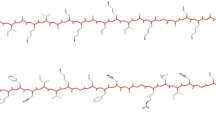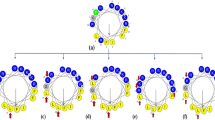Abstract
Antimicrobial peptides, also called body defense peptides, are used against a wide range of pathogens, such as negative- and positive-gram bacteria, mycobacteria, fungi, viruses, etc. Contrary to antibiotics, antimicrobial peptides do not develop resistance. Their wide antimicrobial spectrum situates them as important and attractive targets in research and pharmaceutical industry in order to obtain new structures using modern drug design techniques. We present here eleven QSAR models in which antimicrobial activity expressed as minimal inhibitory concentration values at Bacillus subtilis of 37 mastoparan analogs was correlated with different physicochemical parameters like: number of hydrophobic centers, molecular area and volume, internal dipole moment, refractivity, RPCG (relative positive charges) and number of donor and acceptor atoms generating by use of the computational software Sybyl. Significant R2 (0.68–0.72) correlation coefficients and standard error of prediction SEE (0.199–0.230) were obtained, indicating that the established equations can be used. Thus, these linear models allowed us to create a library of 19 derivatives of mastoparan analogs obtained through computational mutagenesis. We propose this library of compounds as a source of possible derivatives with a more potent antimicrobial activity.

Similar content being viewed by others
References
Akamatsu M (2002) Current state and perspectives of 3D-QSAR. Curr Top Med Chem 2:1381–1394
Bowdish DM, Hancock RE (2005) Anti-endotoxin properties of cationic host defence peptides and proteins. J Endotoxin Res 11:230–236
Brandenburg K, Schromm AB, Gutsmann T (2010) Endotoxins: relationship between structure, function and activity. Subcell Biochem 53:53–67
Cerovsky V, Slaninova J, Fucik V, Hulacova H, Borovickova L, Jezek R, Bednarova L (2008) New potent antimicrobial peptides from the venom of Polistinae wasps and their analogs. Peptides 29:992–1003
Chen Y, Mant CT, Farmer SW, Hancock RE, Vasil ML, Hodges RS (2005) Rational design of α-helical antimicrobial peptides with enhanced activities and specificity/therapeutic index. J Biol Chem 280:12316–12329
Collantes ER, Dunn WJ (1995) Amino acid side chain descriptors for quantitative structure activity relationship studies of peptide analogues. J Med Chem 38:2705–2713
Cornell WD, Cieplak P, Bayly CI, Gould IR, Merz KM, Ferguson DM, Spellmeyer DC, Fox T, Caldwell JW, Kollman PA (1995) A second generation force field for the simulation of proteins, nucleic acids, and organic molecules. J Am Chem Soc 117:5179–5197
Davison G, Allgrove J, Gleeson M (2009) Salivary antimicrobial peptides (LL-37 and alpha-defensins HNP1-3), antimicrobial and IgA responses to prolonged exercise. Eur J Appl Physiol 106:277–284
dos Santos Cabrera MP, Costa ST, de Souza BM, Palma MS, Ruggiero JR, Ruggiero Neto J (2008) Selectivity in the mechanism of action of antimicrobial mastoparan peptide Polybia-MP1. Eur Biophys J 37:879–891
Ebalunode JO, Zheng W, Tropsha A (2011) Application of QSAR and shape pharmacophore modeling approaches for targeted chemical library design. Methods Mol Biol 685:111–133
Frederic C, Cristine AC, Erwan A, David A, Cecile D, Michael F, Jean-Francois H, Martinez J, Solveig LJ, Philippe M, Andrea P, Agnes P, Christopher P, Philippe R, Peter SG, Sherwin W (2005) JLK inhibitors: isocoumarin compounds as putative probes to selectively target the gamma-secretase pathway. Curr Alzheimer Res 2:327–334
Hancock EW, Scott MG (2000) The role of antimicrobial peptides in animal defenses. Proc Natl Acad Sci USA 97:8856–8861
Harris F, Dennison SR, Phoenix DA (2009) Anionic antimicrobial peptides from eukaryotic organisms. Curr Protein Pept Sci 10:585–606
Jenssen H, Fjell CD, Cherkasov A, Hancock RE (2008) QSAR modeling and computer-aided design of antimicrobial peptides. J Pept Sci 14:110–114
Mahalka AK, Kinnunen PK (2009) Binding of amphipathic alpha-helical antimicrobial peptides to lipid membranes: lessons from temporins B and L. Biochim Biophys Acta 1788:1600–1609
Maher S, McClean S (2006) Investigation of the cytotoxicity of eukaryotic and prokaryotic antimicrobial peptides in intestinal epithelial cells in vitro. Biochem Pharmacol 71:1289–1298
Mendes MA, De Sousa BM, Marques MR, Palma MS (2004) Structural and biological characterization of two novel peptides from the venom of the neotropical social wasp Agelaia pallipes palipes. Toxicon 44:67–74
Mikut R (2010) Computer-based analysis, visualization, and interpretation of antimicrobial peptide activities. Methods Mol Biol 618:287–299
Periti P, Mazzei T (1999) New criteria for selecting the proper antimicrobial chemotherapy for severe sepsis and septic shock. Int J Antimicrob Agents 12:97–105
Persson B (2000) Bioinformatics in protein analysis. EXS 88:215–231
Raevsky OA, Skvortsov VS (2005) Quantifying hydrogen bonding in QSAR and molecular modeling. SAR QSAR Environ Res 16:287–300
Snyder RD, Hendry LB (2005) Toward a greater appreciation of noncovalent chemical/DNA interactions: application of biological and computational approaches. Environ Mol Mutagen 45:100–105
Subasinghage AP, Conlon JM, Hewage CM (2010) Development of potent anti-infective agents from Silurana tropicalis: conformational analysis of the amphipathic, alpha-helical antimicrobial peptide XT-7 and its non-haemolytic analogue [G4K]XT-7. Biochim Biophys Acta 1804:1020–1028
Tong J, Liu S, Zhou P, Wu B, Li Z (2008) A novel descriptor of amino acids and its application in peptide. QSAR Theor Biol 253:90–97
Zanetti M, Gennaro R, Skerlavaj B, Tomasinsig L, Circo R (2002) Cathelicidin peptides as candidates for a novel class of antimicrobials. Curr Pharm Des 8:779–793
Zasloff M (2002) Antimicrobial peptides of multicellular organisms. N Engl J Med 347:1199–1200
Zhao X, Yuan M, Huang B, Ji H, Zhu L (2010) Ligand-based pharmacophore model of N-aryl and n-heteroaryl piperazine alpha(1A)-adrenoceptors antagonists using GALAHAD. J Mol Graph Model 29:126–136
Zhu WL, Song YM, Park Y, Park KH, Yang ST, Kim JI, Park IS, Hahm KS, Shin SY (2007) Substitution of the leucine zipper sequence in melittin with peptoid residues affects self-association, cell selectivity and mode of action. Biochim Biophys Acta 1768:1506–1517
Zuo Z, Luo X, Zhu W, Shen J, Shen X, Jiang H, Chen K (2005) Molecular docking and 3D-QSAR studies on the binding mechanism of statine-based peptidomimetics with beta-secretase. Bioorg Med Chem 13:2121–2131
Acknowledgments
We acknowledge the financial support of CNMP PNII 61-016/2007 and CNMP PNII 62-061/2008.
Author information
Authors and Affiliations
Corresponding author
Rights and permissions
About this article
Cite this article
Avram, S., Duda-Seiman, D., Borcan, F. et al. Evaluation of Antimicrobial Activity of New Mastoparan Derivatives Using QSAR and Computational Mutagenesis. Int J Pept Res Ther 17, 7–17 (2011). https://doi.org/10.1007/s10989-010-9235-7
Accepted:
Published:
Issue Date:
DOI: https://doi.org/10.1007/s10989-010-9235-7




